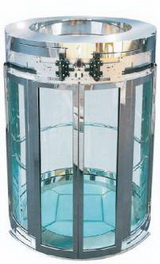Freight Elevators
Freight elevators are used by many businesses to transport machinery and other items between building floors. Unlike traditional elevators, freight elevators are not designed to transport people. These commercial elevators are the most powerful on the market and are often used in various industries. They are available in either electric or hydraulic movements and can carry much heavier weights than elevators used in residences and other buildings. Freight elevators are designed to be durable and to be able to lift up to 6,000 pounds in some cases. Some commercial elevators can reach higher speeds than other types. For instance, a hydraulic elevator that is designed for moving freight can typically travel up to 200 feet per minute which makes them much more convenient for those working on upper floors.
Safety Features on Freight Elevators
Most freight elevators are equipped with various safety features. Alarm buttons are an important safety feature that allows those in the elevator to sign to others if the elevator is experiencing problems or if the left gets stuck. Stop switches are provided on freight elevators to hold open the doors and allow for easier loading and unloading of various items. They often have different fire requirements and codes than elevators that transport people and codes are typically required to be posted on the elevator for inspections. Freight elevators may have manual doors that can be opened and closed without power as well as multiple doors allowing workers to load and unload from different points of the elevator. Most often the inside of a freight elevator is completely unfinished since they are often the subject of bumping and beating from various products.
Movements
Freight elevators can be either traction or hydraulic movement. Traction designs use steel ropes that move the elevator car by ropes pulling through a grooved pulley. Hydraulic models work by using pistons to lift the elevator car. Both traction and hydraulic designs use counter weighting to move the elevator car. Traction lifts are generally a bit more expensive than hydraulics and many feel that the risk of hydraulic elevators leaking oil is bad for the environment. The actual choice of which type is better depends on the specific needs and the budget that is available for the purchase.
Sizes of Freight Lifts
Freight lifts or elevators come in many different sizes. The largest models can be used to carry thousands of pounds worth of machinery and other items easily up and down several different floors. The smallest models are known as dumbwaiters. These are used in many homes to move items such as food, laundry and other necessities up and down between two or more stories. Many older homes have dumbwaiters that operated using a rope to lift the platform. The more modern versions today use a small motor that operates on electricity in which to move the platform easily up and down. When choosing a freight elevator, the size is a major consideration. You should determine the size of the items that you will be lifting as well as a general overview of the weight that will need to be moved.

